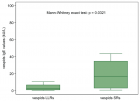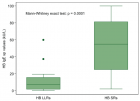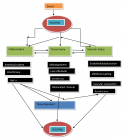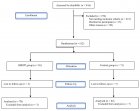Abstract
Research Article
Higher venom-specific IgE levels differentiate children with previous local large reactions from children with previous systemic reactions of different severity
Pastorello Elide Anna*, Borgonovo Linda, Piantanida Marta, Schroeder Jan Walter, Pravettoni Valerio, Pastori Stefano, Bilo’ Maria Beatrice, Toniato Andrea, Aversano Maria Gloria, Farioli Laura, Nichelatti Michele and Preziosi Donatella
Published: 19 March, 2021 | Volume 5 - Issue 1 | Pages: 017-021
Introduction: Risk factors for systemic reactions (SRs) from hymenoptera venom (HV) allergy are well known in the adult population but they have been little studied in the pediatric one.
Method: The aim of our study was to identify risk factors for SRs in a population of children allergic to HV, comparing a series of clinical (age, gender, atopy, asthma) and laboratory (total IgE, tryptase, venom-specific IgE levels) variables between patients with at least two large local reactions (LLRs) and patients with SRs of different severity for the identified insect. We selected a population of HV allergic children aged < 15 years with LLRs or SRs stratified according to Mueller grades after stinging.
Results: The population included 80 children, 35 with at least 2 LLRs and 45 with SRs. The level of specific IgE for vespid (Polistes dominula, Vespula species) venoms was significantly higher (p = 0.0321) in children with SRs (Mueller grade II+III+IV) than in those with LLRs and the same significance was also found for specific IgE for Apis mellifera, considering SRs group (Mueller grade I+II+III+IV) in respect with LLRs group (p = 0.0001).
Conclusion: The main difference in our pediatric population was the highest level of specific IgE in children with a history of SRs compared to those with a history of LLRs for both vespids and honey bees. These results, once confirmed on a larger population, could suggest the opportunity to follow the behavior of venom specific IgE in children with LLRs to reveal a risk to develop future more serious reactions.
Read Full Article HTML DOI: 10.29328/journal.aaai.1001025 Cite this Article Read Full Article PDF
Keywords:
Hymenoptera venom; Large local reactions; Systemic reactions; Specific venom IgE; Children
References
- Mullins RJ, Dear KB, Tang ML. Time trends in Australian hospital anaphylaxis admissions in1998-1999 to 2011-2012. J Allergy Clin Immunol. 2015; 136: 367-375. PubMed: https://pubmed.ncbi.nlm.nih.gov/26187235/
- Turner PJ, Gowland MH, Sharma V, Ierodiakonou D, Harper N, et al. Increase in anaphylaxis-related hospitalizations but no increase in fatalities: an analysis of United Kingdom national anaphylaxis data. 1992-2012. J Allergy Clin Immunol. 2015; 135: 956-963. PubMed: https://pubmed.ncbi.nlm.nih.gov/25468198/
- Mullins RJ, Wainstein BK, Barnes EH, Liew WK, Campbell DE. Increases in anaphylaxis fatalities in Australia from 1997 to 2013 Clin Exp Allergy. 2016; 46: 1099-1110. PubMed: https://pubmed.ncbi.nlm.nih.gov/27144664/
- Grabenhenrich LB, Dölle S, Moneret-Vautrin A, Kohli A, Lange L, et al. Anaphylaxis in children and adolescents: The European Anaphylaxis Registry. J Allergy Clin Immunol. 2016; 137: 1128-1137. PubMed: https://pubmed.ncbi.nlm.nih.gov/26806049/
- Golden DB, Demain J, Freeman T, Graft D, Tankersley M, et al. Stinging insect hypersensitivity: A practice parameter update 2016. Ann Allergy Asthma Immunol. 2017; 118: 28-54. PubMed: https://pubmed.ncbi.nlm.nih.gov/28007086/
- Sturm GJ, Varga EM, Roberts G, Mosbech H, Bilò MB, et al. EAACI guidelines on allergen immunotherapy: Hymenoptera venom allergy. Allergy 2018; 73: 744-764. PubMed: https://pubmed.ncbi.nlm.nih.gov/28748641/
- Golden DB. Insect allergy in children. Curr Opin Allergy Clin Immunol. 2006; 6: 289-293.
- Bilò MB, Pravettoni V, Bignardi D, Bonadonna P, Mauro M, et al. Hymenoptera Venom Allergy: Management of Children and Adults in Clinical Practice. J Investig Allergol Clin Immunol. 2019; 29: 180-205. PubMed: https://pubmed.ncbi.nlm.nih.gov/30183660/
- Yavuz ST, Sahiner UM, Buyuktiryaki B, Soyer OU, Sakesen C, et al. Clinical features of children with venom allergy and risk factors for severe systemic reactions. Int Arch Allergy Immunol. 2013; 160: 313-321. PubMed: https://pubmed.ncbi.nlm.nih.gov/23095437/
- Graif Y, Romano-Zelekha O, Livne I, Green MS, Shohat T. Increased rate and greater severity of allergic reactions to insect sting among schoolchildren with atopic disease Pediatr Allergy Immunol. 2009; 20: 757-762. PubMed: https://pubmed.ncbi.nlm.nih.gov/19397756/
- Bilò MB, Martini M, Pravettoni V, Bignardi D, Bonadonna P, et al. Large local reactions to Hymenoptera stings: Outcome of re-stings in real life. Allergy 2019; 74(: 1969-1976. PubMed: https://pubmed.ncbi.nlm.nih.gov/31074868/
- Severino M, Bonadonna P, Passalacqua G. Large local reactions from stinging insects: from epidemiology to management. Curr Opin Allergy Clin Immunol. 2009; 9: 334-337. PubMed: https://pubmed.ncbi.nlm.nih.gov/19458526/
- Mueller HL. Diagnosis and treatment of insect sensitivity J Asthma Res. 1966; 3: 331-333. PubMed: https://pubmed.ncbi.nlm.nih.gov/4380730/
- Blum S, Gunzinger A, Muller UR, Helbling A. Influence of total and specific IgE, serum tryptase and age on severity of allergic reactions to Hymenoptera stings. Allergy. 2011; 66: 222-228. PubMed: https://pubmed.ncbi.nlm.nih.gov/20880144/
- Tripolt P, Arzt-Gradwohl, Cerpes U, Laipold K, Binder B, et al. Large local reactions and systemic reactions to insect stings: similarities and differences. Plos One. 2020; 16: 1-8.
- Soyygit S, Arslan S, Caliskaner AZ. Investigation of the factors that determine the severity of allergic reactions to hymenoptera venoms. Allergy and Asthma Proceedings. 2019; 40: 116-122. PubMed: https://pubmed.ncbi.nlm.nih.gov/30819281/
- Pastorello EA, Borgonovo L, Preziosi D, Schroeder JW, Pravettoni V, et al. Basal Tryptase high levels associated with a history of arterial hypertension and hipercholesterolemia represent risk factors for severe anaphylaxis in Hymenoptera venom Allergic subjects over 50 years old. Int Arch Allergy Immunol. 2020; 1-7. PubMed: https://pubmed.ncbi.nlm.nih.gov/33264768/
- Turner PJ, Jerschow E, Umasunthar T, Lin R, Campbell DE, et al. Fatal Anaphylaxis: Mortality Rate and Risk Factors J Allergy Clin Immunol Pract. 2017; 5: 1169-1178. PubMed: https://www.ncbi.nlm.nih.gov/pmc/articles/PMC5589409/
- Farioli L, Losappio LM, Schroeder JW, Preziosi D, Scibilia J, et al. Basal tryptase levels can predict clinical severity in hymenoptera venom anaphylaxis and ischemic cardiovascular disorders J Investig Allergol Clin Immunol. 2019; 29: 162-164. PubMed: https://pubmed.ncbi.nlm.nih.gov/31017123/
- Solley GO. Stinging and biting insect allergy: an Auxtralian experience. Ann Allergy Asthma Immunol. 2004; 93: 532-537. PubMed: https://pubmed.ncbi.nlm.nih.gov/15609761/
- Sturm GJ, Heinemann A, Schuster C, Wiednig M, Groselj-Strele A, et al. Influence of total IgE levels on the severity of sting reactions in Hymenoptera venom allergy. Allergy. 2007; 62: 884-889. PubMed: https://pubmed.ncbi.nlm.nih.gov/17620065/
- Stebbings Jr JH. Immediate Hypersensitivity: a defence against arthropods? Perspect Biol Med. 1974; 17: 233-239. PubMed: https://pubmed.ncbi.nlm.nih.gov/4273175/
- Profet M. The function of allergy: Immunological defence against toxins. Q Rev Biol. 1991; 66: 23-62. PubMed: https://pubmed.ncbi.nlm.nih.gov/2052671/
- Mukai K, Tsai M, Starkl P, Marichal T, Galli SJ. IgE and mast cells in host defense against parasites and venoms. Semin Immunopathol. 2016: 38: 581-603. PubMed: https://pubmed.ncbi.nlm.nih.gov/27225312/
- Galli SJ, Starkl P, Marichal T, Tsai M. Mast cells and IgE in defense against venoms: possible “good side” of allergy? Allergol Int. 2016; 65: 3-15. PubMed: https://pubmed.ncbi.nlm.nih.gov/26666482/
Figures:

Figure 1

Figure 2
Similar Articles
-
Atopic Conjunctivitis in Children: Influence of Treatment with Topical Cyclosporin 0.05% in the Quality of LifeCarlos Alberto Sánchez Salguero*,Álvaro Isidro Sánchez Chacón. Atopic Conjunctivitis in Children: Influence of Treatment with Topical Cyclosporin 0.05% in the Quality of Life . . 2017 doi: 10.29328/journal.haard.1001001; 1: 001-008
-
Chemo-cytokines network is main target for control of Allergic asthmaSeyyed Shamsadin Athari*,Seyyede Masoume Athari. Chemo-cytokines network is main target for control of Allergic asthma. . 2018 doi: 10.29328/journal.aaai.1001009; 2: 001-002
-
Role of Serum Magnesium levels in Asthmatic with childrenSomashekar AR*,Ramakrishnan KG,Seyyed Vanitha Gowda. Role of Serum Magnesium levels in Asthmatic with children. . 2018 doi: 10.29328/journal.aaai.1001010; 2: 003-005
-
Diagnosis of Asthma in Childhood AgeIbrahim A Ali*,Elia Adil Nabih,Ahmed MS Eltohami. Diagnosis of Asthma in Childhood Age . . 2018 doi: 10.29328/journal.aaai.1001012; 2: 008-012
-
Helping asthmatic children through bonding therapyAntonio Madrid*,Nicholas Bennett. Helping asthmatic children through bonding therapy. . 2021 doi: 10.29328/journal.aaai.1001022; 5: 001-007
-
Higher venom-specific IgE levels differentiate children with previous local large reactions from children with previous systemic reactions of different severityPastorello Elide Anna*,Borgonovo Linda,Piantanida Marta,Schroeder Jan Walter,Pravettoni Valerio,Pastori Stefano,Bilo’ Maria Beatrice,Toniato Andrea,Aversano Maria Gloria,Farioli Laura,Nichelatti Michele,Preziosi Donatella. Higher venom-specific IgE levels differentiate children with previous local large reactions from children with previous systemic reactions of different severity. . 2021 doi: 10.29328/journal.aaai.1001025; 5: 017-021
-
An algorithm to safely manage oral food challenge in an office-based setting for children with multiple food allergiesNathalie Cottel,Aïcha Dieme,Véronique Orcel,Yannick Chantran,Mélisande Bourgoin-Heck,Jocelyne Just. An algorithm to safely manage oral food challenge in an office-based setting for children with multiple food allergies. . 2021 doi: 10.29328/journal.aaai.1001027; 5: 030-037
Recently Viewed
-
Breast Imaging Services Utilization Trends Across Private and Government-Insured Patients in a National Radiology PracticeAndrew K Hillman*,Phil Ramis,Patrick Nielsen,Sophia N Swanston,Dana Bonaminio,Eric M Rohren. Breast Imaging Services Utilization Trends Across Private and Government-Insured Patients in a National Radiology Practice. J Clin Med Exp Images. 2025: doi: 10.29328/journal.jcmei.1001037; 9: 020-027
-
Trends of Antibiotic Resistance among Uropathogens in Medical vs. Non-Medical Departments of Al-Shifa Medical Complex in Gaza Strip: A Retrospective, Cross-Sectional StudyKhaled Alkhodari*, Yasmin Al-Shurafa, Hammam AL-louh, Rafat Lubbad. Trends of Antibiotic Resistance among Uropathogens in Medical vs. Non-Medical Departments of Al-Shifa Medical Complex in Gaza Strip: A Retrospective, Cross-Sectional Study. Int J Clin Microbiol Biochem Technol. 2024: doi: 10.29328/journal.ijcmbt.1001028; 7: 001-005
-
The Bacteriological Profile of Nosocomial Infections at the Army Central Hospital of BrazzavilleMedard Amona*,Yolande Voumbo Matoumona Mavoungou,Hama Nemet Ondzotto,Benjamin Kokolo,Armel Itoua,Gilius Axel Aloumba,Pascal Ibata. The Bacteriological Profile of Nosocomial Infections at the Army Central Hospital of Brazzaville. Int J Clin Microbiol Biochem Technol. 2025: doi: 10.29328/journal.ijcmbt.1001032; 8: 009-022
-
The Pierre Marie-Sainton syndrome: Report of a familySalem Y*,Omar Y,Dorsaf S,Sonia M,Samir B,Olfa B . The Pierre Marie-Sainton syndrome: Report of a family. J Oral Health Craniofac Sci. 2019: doi: 10.29328/journal.johcs.1001028; 4: 012-014
-
Gentian Violet Modulates Cytokines Levels in Mice Spleen toward an Anti-inflammatory ProfileSalam Jbeili, Mohamad Rima, Abdul Rahman Annous, Abdo Ibrahim Berro, Ziad Fajloun, Marc Karam*. Gentian Violet Modulates Cytokines Levels in Mice Spleen toward an Anti-inflammatory Profile. Arch Asthma Allergy Immunol. 2024: doi: 10.29328/journal.aaai.1001034; 8: 001-006
Most Viewed
-
Causal Link between Human Blood Metabolites and Asthma: An Investigation Using Mendelian RandomizationYong-Qing Zhu, Xiao-Yan Meng, Jing-Hua Yang*. Causal Link between Human Blood Metabolites and Asthma: An Investigation Using Mendelian Randomization. Arch Asthma Allergy Immunol. 2023 doi: 10.29328/journal.aaai.1001032; 7: 012-022
-
Impact of Latex Sensitization on Asthma and Rhinitis Progression: A Study at Abidjan-Cocody University Hospital - Côte d’Ivoire (Progression of Asthma and Rhinitis related to Latex Sensitization)Dasse Sery Romuald*, KL Siransy, N Koffi, RO Yeboah, EK Nguessan, HA Adou, VP Goran-Kouacou, AU Assi, JY Seri, S Moussa, D Oura, CL Memel, H Koya, E Atoukoula. Impact of Latex Sensitization on Asthma and Rhinitis Progression: A Study at Abidjan-Cocody University Hospital - Côte d’Ivoire (Progression of Asthma and Rhinitis related to Latex Sensitization). Arch Asthma Allergy Immunol. 2024 doi: 10.29328/journal.aaai.1001035; 8: 007-012
-
An algorithm to safely manage oral food challenge in an office-based setting for children with multiple food allergiesNathalie Cottel,Aïcha Dieme,Véronique Orcel,Yannick Chantran,Mélisande Bourgoin-Heck,Jocelyne Just. An algorithm to safely manage oral food challenge in an office-based setting for children with multiple food allergies. Arch Asthma Allergy Immunol. 2021 doi: 10.29328/journal.aaai.1001027; 5: 030-037
-
Snow white: an allergic girl?Oreste Vittore Brenna*. Snow white: an allergic girl?. Arch Asthma Allergy Immunol. 2022 doi: 10.29328/journal.aaai.1001029; 6: 001-002
-
Cytokine intoxication as a model of cell apoptosis and predict of schizophrenia - like affective disordersElena Viktorovna Drozdova*. Cytokine intoxication as a model of cell apoptosis and predict of schizophrenia - like affective disorders. Arch Asthma Allergy Immunol. 2021 doi: 10.29328/journal.aaai.1001028; 5: 038-040

If you are already a member of our network and need to keep track of any developments regarding a question you have already submitted, click "take me to my Query."
















































































































































